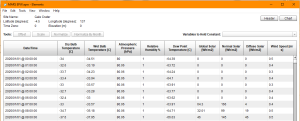
Thomas Lagarde, Ingénieur système pour habitats dans les environnements extrèmes (System engineer for extreme environment habitats) has developed a Grasshopper code base that imports the results of a SIMOC simulation, then generates a 3D Mars base that corresponds to the parameters configured by the SIMOC user.
As presented at IAC 2021, Thomas developed this unique project to demonstrate the possibility of using existing solutions and concepts developed and used for earth applications as a design architecture for outer-space habitats. The future habitats/cities will need to evolve constantly, fixing a form, a system or a program is not the solution to adapt to an environment that we will learn a lot from when we get there. The design for a habitat and its systems will require constant modifications to adapt to changes in the environment, our knowledge of it and/or our reaction to it. Interior and exterior organizations will certainly change rapidly depending on new requirements. To produce an optimal design at a fast pace and correctly we need to use computational techniques such as parametric design or topology optimization. The new design solution should be the best according to a chosen set of conditions. For example: well-being, comfort, ease of operation and construction. With the help of software such as Rhino/Grasshopper and SIMOC we can demonstrate the practicality and the necessity of this approach for future human settlements in any extreme environment.



